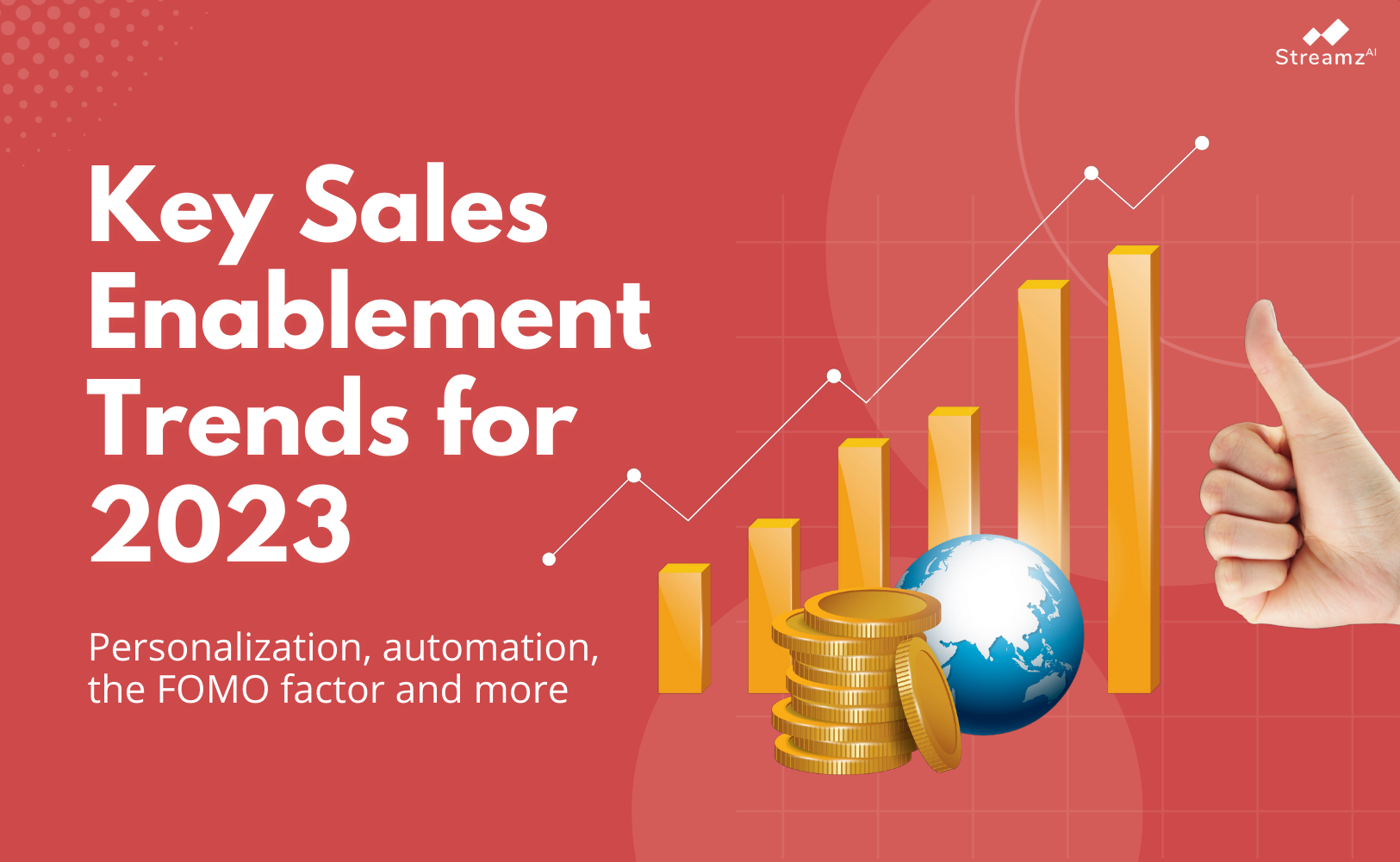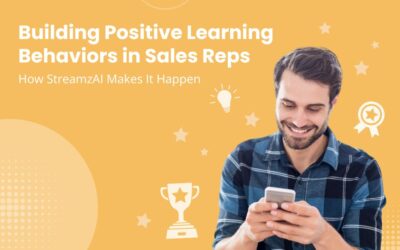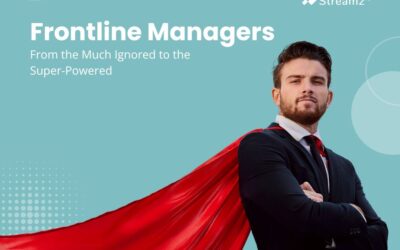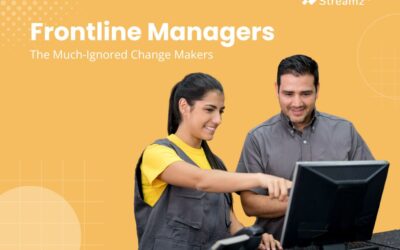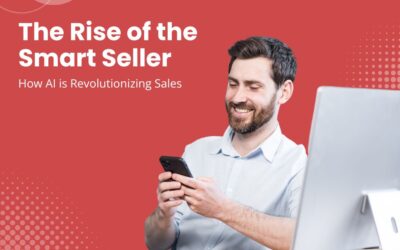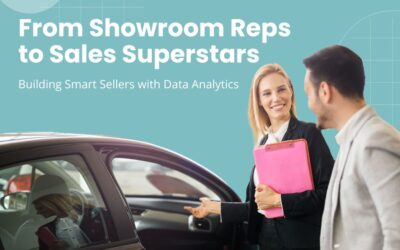Sales enablement platforms crucially help in aligning the objectives of a company and the success of its frontline sales teams. These platforms, offering an array of sales technology tools, are growing exponentially, and not without reason. The global sales enablement platform market size which was pegged at USD 2.02 billion in 2021, is predicted to reach USD 10.57 billion by 2030, growing at a compounded annual growth rate (CAGR) of 19.7%. Hence, tracking sales enablement trends gives pointers to organizations to develop their future sales enablement strategy.
Evolving digital transformation in company operations has contributed to the rapid growth of sales enablement and readiness technology. Customers of sales enablement platforms can also benefit from cost reduction in their operations. It also helps to transform sales reps into winners, beat the forgetting curve, and stay ahead of the competition. In a study conducted by Accenture, employee training programs invested in by companies have received a 353% ROI!
As the technology landscape evolves, technology assumes the role of a disruptor shaping trends in the sales world. Sales leaders should look out for these disruptions and know which trends to follow depending on organizational goals. Let us explore the key sales enablement trends for 2023.
However, firstly let us understand the importance of sales enablement platforms in a nutshell.
Why are sales enablement platforms so crucial?
Sales enablement and readiness is a cross-functional and strategic technology framework. Sales reps benefit from this framework’s best practices, knowledge, tools, and resources which help them succeed. Some of its remarkable features that help sales reps include gamification, role-play videos, microlearning, and certifications amongst others. This helps in their learning and bestows them with rewards and recognition for encouragement. Thus, sales reps will see their productivity increase and can successfully interact with customers from prospecting to closing. A sales enablement platform also acts as a central repository for sales communication content collected from various company divisions. Hence, access to it helps sellers get the right information quickly. Ultimately there is an increase in company revenues and a reduction in the churn of sales reps due to greater job satisfaction.
Sales enablement tools should be easy in functionality and offer seamless integration with existing systems. Features like content management, mobile friendliness and data crunching capability for analytics are also desirable. It is no wonder that in the last five years, there has been a 343% rise in the adoption of sales enablement tools.
See Also: How does Sales Readiness Differ from Sales Enablement?
Stats which tell why sales enablement tools are here to stay:
- Sales teams powered with sales enablement tools for more than two years have experienced 48% higher customer engagement.
- Sales rep training initiatives conducted with technology have witnessed 10% more sales rep engagement. Sales reps onboarded in a similar manner are likely to see a quicker ramp-up time by 26%.
- 65% of sales leaders who use these sales tools have overshot revenue targets.
These stats highlight the benefits of adopting technology into sales processes to achieve an efficient, effective, and productive sales team. As the behavior of customers keeps changing, sales enablement trends are also evolving continuously. Hence, sales and training managers should update themselves with the latest sales enablement trends to match the expectations of buyers.
Let us now give you a list of the hottest trends in this sector to watch out for in 2023. These will help you plan your strategy for your sales readiness program.
The key emerging sales enablement trends for 2023
1. Personalization – Sales enablement with precision
Capable sales enablement platforms give personalized training and assessment to individual sales reps as part of their coaching. A good sales enablement platform will not assess en masse. AI-enabled platforms help send each sales rep, a set of different and unique questions to answer. These questions estimate the extent of each sales rep’s knowledge and skill gaps. Learning material is provided to reduce these gaps. Thus, AI works at a personal level with AI-led recommendations unique to each sales rep. With these content recommendations, assessments for the sales reps run in continuous loops week after week based on different parameters. Later, sales reps have nudges or alerts sent to them to take action to improve if poor scores persist.
See Also: Leading Sales Coaching Tools for Onboarding and Upskilling Sales Reps in 2023
Sales enablement platforms also help with providing buyer-centric content to sales reps which goes a long way in personalized selling. Thus, sales reps can sell more, faster. 77% of B2B customers voice out that sales reps only have generic solutions and don’t understand their challenges, in order to provide solutions to those individual challenges. They feel that the products or services marketed by sales reps fail to have any bearing on their problem issues. In fact, 75% of these customers share that sales reps fall short of the knowledge required in their domain. This becomes more pronounced currently because buyers thoroughly research products and services online before interacting with sales reps. Sometimes they are more knowledgeable than the sales reps who then cut a sorry figure for themselves. Hence, 87% of buyers will choose a product or service if the sales reps convince them as to the product or service fulfilling more than their unmet needs. They are more impressed with sales reps who can clearly articulate the benefits of the product or service. This is where personalization is the mantra.
2. AI makes sales enablement smarter
Artificial intelligence helps in the forward momentum of all sales processes. This includes onboarding and coaching of sales reps, the opportunities and challenges in selling, and the sales team’s performance. Industry adoption of AI is racing ahead and the below facts just prove that:
- According to a research study by Gartner, by 2025 75% of B2B sales organizations will fortify sales playbooks with AI which helps in targeted selling.
- The Gartner 2021 CSO Priorities Pulse Survey states that 88% of chief sales officers are using or considering using AI enabled analytical tools and technology.
- In the years between 2018 and 2020, the count of sales teams using AI shot up 155%.
- 74% of sales professionals using intelligence tools have said that it has played a decisive role in closing deals.
See Also: Best Practices for Conducting Sales Knowledge Checks
Stunning developments in AI and machine learning have prompted sales enablement chiefs to restructure how they coach sales reps. AI-aided tools help measure each sales rep’s knowledge and skill gaps at a scale of thousands. It later automatically sends out recommendations to each sales rep to plug those gaps.
AI-aided sales enablement helps provide requisite information to showroom sales reps, distributed sales reps, and promoters right when they face customers. It also facilitates sales reps to figure out the best way to reach out to their customers, i.e. whether by phone or email, or video chat. There are tools offering real time meeting transcription and automation in taking notes. Predictive analytics tools here use algorithms to make a connection between the customer interaction data and results, to pinpoint leads or lags.
Another feather in the hat for AI is conversation intelligence tools catering to sales reps. These tools read their emails and listen to their sales calls stealthily. During their conversations with customers, it analyzes various parameters in real time. These include inflections in their voice, confidence, usage of the right words, duration of the conversation, and the frequency of the customer talking. These activities will ultimately suggest to each sales rep how to up their performance and mend shortcomings.
Automation is Here to Stay…
A recent McKinsey study revealed that more than 50% of daily repetitive tasks performed by sales reps could be automated with the help of AI. These tasks include sales data entry, customer information recording, taking orders, scheduling meetings, making calls, email outreach, drafting proposals, and qualifying leads. This would help free up time for sales reps caught in mundane work. They then can invest more time in improving knowledge, upskilling, data analytics, retaining customers, and closing deals faster. Sales enablement is streamlining existing sales processes and automating them while ensuring seamless integration with core company systems like SAP amongst others.
3. Correlation of learning & metrics: A litmus test for sales enablement
A successful sales enablement program should result in a measurable impact on the business.
If the impact is positive it shows that there is a competency improvement. It is a revelation of how sales reps are processing and retaining knowledge throughout the training. It also indicates whether they are applying the concepts learned through demonstrable behavior.
According to The Sales Enablement Analytics Report 2020-2021:
- Companies that evaluate competency improvement gain an average rep quota attainment that is 6 percentage points greater than those that don’t.
- Enterprises that measure behavioral change after training achieve an average rep quota attainment that is 7 percentage points more than those that don’t.
Competency improvement as a sales training metric gains value when evaluated both before and after training. This will estimate whether the sales enablement effort produces the anticipated behavioral outcome through learning. For instance, the time spent by sales reps in training pitched against the time spent by them in selling will correlate time to performance. The outcome will help sales managers to tweak the training program if it does not produce the desired results.
Important lead metrics for analysis of the sales reps’ performance include the count of content views, exercises completed by sales reps, certifications generated, number of calls or role plays recorded, frequency of explanations given to customers, and coaching activities of managers.
4. High engagement features keep sales reps more active and reassured
An intelligent sales enablement platform keeps sales reps incessantly engaged through its high engagement features like insights and analytics, gamification, onboarding management, micro-learning and AI driven notifications. It helps to continuously assess sales reps. Thus, their productivity quotient increases dramatically.
It is a tough call to keep sales reps engaged to the maximum during onboarding, training, and other regular sales activities. Therefore, the introduction of an entertainment factor like gamification during learning helps engage sales reps more. It includes theme-based contests, quizzes, and leaderboards to make learning fun and interactive among sales reps. Incentivizing the learning activities of the reps is possible through rewards and recognition. Another high-engagement feature is microlearning. Here, sales reps are provided short feeds or chunks of information regularly and appropriately, for reinforcement of memory. High engagement features make sales reps feel reassured that they are constantly guided on how to carry out their activities.
5. Selling goes hybrid, enablement goes hybrid too
The Covid pandemic accelerated remote selling. Now, as the pandemic settles down worldwide a mix of in-person and remote selling — termed ‘Hybrid Selling’ is the new norm in sales lingo. This is largely due to customer demand for remote-first engagement and sellers prefer this format too, creating a win-win state of affairs for both.
Today’s B2B customers seek an optimum mix of the warmth of in-person interactions and the convenience of remote contact via phone or video depending on their needs. Hence, more than 90% of companies are making hybrid selling with an emphasis on remote-first de facto. This kind of omnichannel set-up is a more flexible, scalable, real-time, and profitable way to reach prospects. Digital engagement is matching person-to-person engagement due to advanced technology; and seamless and cheap connectivity. Hybrid selling is here to stay simply because it works. In fact, remote sales reps can reach out to four times more contacts than traditional face-to-face interaction with prospects thereby generating up to 50% more revenue.
See Also: Psychology of Sales Gamification
A hybrid setup will affect the sales enablement strategies going forward as more self-learning and webinar formats are created online. Previously, in traditional classroom learning, there was no context given to sales reps prior to the coach arriving and teaching. Thus, the time to coach was lengthy and sales reps were expected to remember the huge amount of information bombarded at them. In the modern sales enablement set-up, currently of the hybrid variety, prior to the physical session with the coach, sales reps are expected to self-learn online through digital reading material and videos. Pre-assessment is also done before the physical session. This ensures that a context is built for the sales reps before the actual session with the instructor. It leads to using less time for the instructor, thus saving on the pricey costs of coaching.
Sometimes due to various constraints instead of a live session with the instructor, a webinar is also conducted which mimics a physical session. Here, pre-webinar preparation is also given to provide context for the webinar, leading to effective learning. After the webinar, a trail-on effect can be generated by post-webinar assessments to check on the sales rep. This is what hybrid means in an enablement context and it assumes significance with both pre and post interventions.
6. Being social media savvy – The FOMO factor
More than 81% of potential customers research online before purchasing and the sources of research include social media. Hence, it is important to target the buyers active on social media. All growth-oriented companies should tap into this hugely important segment. Your organization’s content on social media platforms shapes the image of your company in the minds of users before a sales rep contacts them. Therefore, it is pertinent to emphasize the benefits of your products or services out there. 72% of sales reps exceed their quota by nearly 23% when they make use of social media channels. An equal percentage of sales reps outdo those who don’t dip their toes into these platforms.
In stores, reps and promoters make use of social media by posting on Instagram or Facebook and also encourage customers to post ratings on the reviews page. For a B2B sales rep, it helps to be active on LinkedIn and follow up with the latest online trends.
7. The empowered manager – Being in the driver’s seat
An organization’s strategy to achieve its objectives should be connected to the processes to carry out the execution of its goals. It’s something that all professionals are aware of. Yet many enterprises stumble with processes! They don’t possess the tools and systems enabled by technology to tie strategy and execution together. In any company selling products or services, sales managers are tasked with tracking the performance of their sales reps. It makes sense then, to provide them with sales enablement tools to do this critical activity of theirs. This empowers sales managers to make crucial data-driven decisions about their sales reps’ performance based on verifiable metrics provided by sales enablement platforms.
In the hierarchy of the sales ecosystem; the sales manager, the sales leader, and the sales enablement team have to work together to ensure that the sales reps execute the sales strategy of the company. This can be termed as ‘connected execution’. They are all empowered hugely if they use sales enablement technology to improve sales rep productivity. The end result is largely bigger deals, speedy sales cycles, and enhanced win rates. Along the lines of connected execution, sales enablement tools alert the sales manager and super manager (manager’s manager) on the performance of the sales reps. Thus, managers can manage the show remotely, getting empowered to make quick decisions in the process, to keep productivity high.
Conclusion
You may have harbored beliefs about whether investing in AI-aided sales enablement platforms is an additional cost to your business. You may think otherwise now. Sales enablement solutions in essence mean evolving innovation to stay ahead of the curve. These technology tools integrate with existing enterprise systems making usage easy, effective, and efficient. Increased productivity of sales reps from data-driven decisions leads to increased revenue for enterprises using these technologies. Especially so, when your customers are wary of spending due to an impending economic downturn worldwide. They need to see the value of your products and services before they spend.
Reading about these trends in sales enablement may help plan future strategies for your sales teams. Aligning your sales enablement and readiness goals to the prevailing trends can better the prospects for your enterprise. Sales enablement is going to make a massive difference between productive and unproductive organizations. Streamz, a leading AI-based mobile-first sales enablement, and readiness platform would be happy to further your objectives here.
